Listen: we're not going to sugar-coat this for you. You deserve better than that.
Scranton did have a culinary heritage that P was actually looking forward to seeing again. And it burned down days before our visit. That meant our first meal in town was not a chili-covered hot-dog lovingly prepared on an old, Greek man's arm, but rather a bland lunch from Perkins. And man was it packed at lunch time. This is the sad thing about Scranton; it still has a handful of family-run places hanging on in the crumbling city, but most of the population flocks to the clusters of chain restaurants and malls that have sprung up around it's perimeter.
Scranton was once a booming city with beautiful downtown buildings (funded by the local coal industry) and earned its nickname as the "Electric City" for having the first electrified streetcar in the nation. The city still has one of the largest St. Patrick's Day parades in the country, but today its main claim to fame is its association with the American version of The Office. Mind you, the show is only set in Scranton; it's not filmed there. We did however see a nicely painted diorama celebrating the show's characters in the mall. We didn't see much else.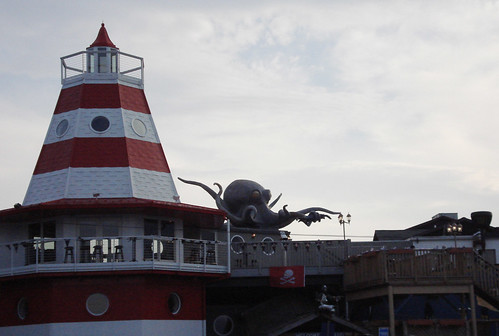 Things picked up on Sunday night when we went to one of P's childhood favorites, a seafood restaurant shaped, yes, shaped, like a pirate ship. P did not always have gourmet tastes, but he knew an awesome concept when he saw one. Cooper's Seafood has sadly covered over most of the ship-shape with a new "lighthouse" bar & gift shop, but you can still glimpse the tentacles of a giant octopus strangling a sailor just behind. The restaurant is filled with Hollywood bric-a-brac and a lot of local memorabilia and city history - where better for A to be introduced to Scranton's glorified days of yore?
Things picked up on Sunday night when we went to one of P's childhood favorites, a seafood restaurant shaped, yes, shaped, like a pirate ship. P did not always have gourmet tastes, but he knew an awesome concept when he saw one. Cooper's Seafood has sadly covered over most of the ship-shape with a new "lighthouse" bar & gift shop, but you can still glimpse the tentacles of a giant octopus strangling a sailor just behind. The restaurant is filled with Hollywood bric-a-brac and a lot of local memorabilia and city history - where better for A to be introduced to Scranton's glorified days of yore? 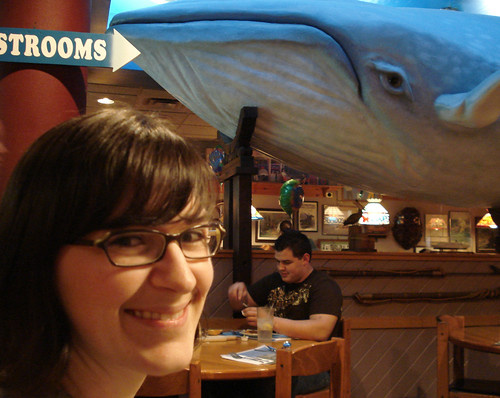 We didn't get to sit in the room with the model train that runs around the ceiling (P was crushed), but we did sit in a room that looked an awful lot like the Museum of Natural History. Since the atmosphere was the real draw at Cooper's, we won't get into too much detail with the food. A did sup on a surprisingly delicious crab bisque; though this may be less than surprising given how much cream and butter was likely in the soup.
We didn't get to sit in the room with the model train that runs around the ceiling (P was crushed), but we did sit in a room that looked an awful lot like the Museum of Natural History. Since the atmosphere was the real draw at Cooper's, we won't get into too much detail with the food. A did sup on a surprisingly delicious crab bisque; though this may be less than surprising given how much cream and butter was likely in the soup.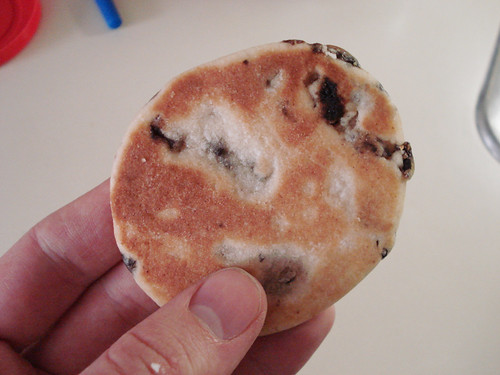 The gustatory pleasures of the next day were considerably greater than the first. In the morning, P's grandmother offered us some church fundraiser Welsh cookies, perhaps one of the better culinary contributions of Wales. Resembling tiny currant-studded pancakes, they tasted more like raw cookie dough. As eating cookie dough together is one our great marital joys, this felt like a second honeymoon.
The gustatory pleasures of the next day were considerably greater than the first. In the morning, P's grandmother offered us some church fundraiser Welsh cookies, perhaps one of the better culinary contributions of Wales. Resembling tiny currant-studded pancakes, they tasted more like raw cookie dough. As eating cookie dough together is one our great marital joys, this felt like a second honeymoon.
After trips to visit two of P's grandparents at the cemetery and a few more car-loops around the city, we ended up at one of the remaining family restaurants: Sibio's. The service left something to be desired, but the food was remarkably tasty Italian-American fare. A ordered the stuffed eggplant - mounds of creamy ricotta rolled in thin strips of eggplant. What would you expect to be on the side? Mashed potatoes and broccoli, of course. P's plate of rigatoni swimming in garlicky olive oil and peppered with spicy sausage, raab, and white beans was equally delicious. On the way out, we heard our waitress threaten to kick one of cooks in the face, so we were glad to escape, having eaten our fill. Even though the hot dog counter had burned down and a lighthouse obscured the former pirate-ship seafood house, the penultimate Scranton meal remained. Old Forge pizza, from the so-called (by its inhabitants) "Pizza Capitol of the World," almost defies description and nowhere does it better than Revello's. The crust is like a dried-out foccaccia, the sauce is neon red and slightly tangy, and the cheese (oh, the cheese) is a sticky mess that clings to your front teeth with every bite. Needless to say, it's more than the sum of it's parts.
Even though the hot dog counter had burned down and a lighthouse obscured the former pirate-ship seafood house, the penultimate Scranton meal remained. Old Forge pizza, from the so-called (by its inhabitants) "Pizza Capitol of the World," almost defies description and nowhere does it better than Revello's. The crust is like a dried-out foccaccia, the sauce is neon red and slightly tangy, and the cheese (oh, the cheese) is a sticky mess that clings to your front teeth with every bite. Needless to say, it's more than the sum of it's parts. 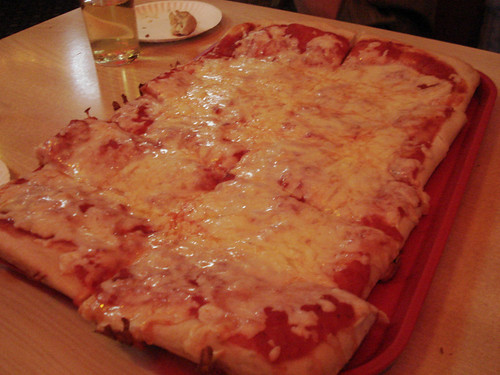 This pizza is wildly addictive and, even as we write this, we long to return to Scranton if only for one more slice. We both feel determined to recreate this delicacy, but the cheese remains elusive. Our best guess is that it's mostly white, processed American.
This pizza is wildly addictive and, even as we write this, we long to return to Scranton if only for one more slice. We both feel determined to recreate this delicacy, but the cheese remains elusive. Our best guess is that it's mostly white, processed American.
As we boarded the Greyhound that evening, P's grandmother climbed on board to make sure we took the one remaining, greasy pizza slice, sandwiched between two paper plates. Though we couldn't bring ourselves to eat it (after a tray-and-a-half at Revello's), the smell comforted us all the way back to the New York.
__________
Cooper's Seafood House - 701 N. Washington Ave, Scranton, PA
Sibio's - 1099 Quincy Ave, Scranton, PA
Revello's Pizza - 502 S. Main Street, Old Forge, PA
And, for when it reopens: Coney Island Texas Lunch - 100 Cedar Avenue, Scranton, PA 18503
Wednesday, April 30, 2008
weekend in scranton
Posted by
a
at
9:51 PM
2
comments
![]()
Tuesday, April 29, 2008
The city that never sleeps is always eating.
For the privilege of eating our fill in New York, we paid with the clothes off our backs. Literally. That's thanks to Northwest Airlines (aka. "The Devil of the Skies"), who turned our hour-and-a-half layover in Minnesota into a fifteen minute mad dash to catch our connection. Needless to say, our bags couldn't run that fast. So if we happen to look a little haggard in our first few days of photos, you know why.
When we'd left Portland, the forecast for the weekend predicted some unseasonably-late snow, so we were pretty pleased to wake up Saturday at P's uncles' house in New Jersey to find 75 degree weather. 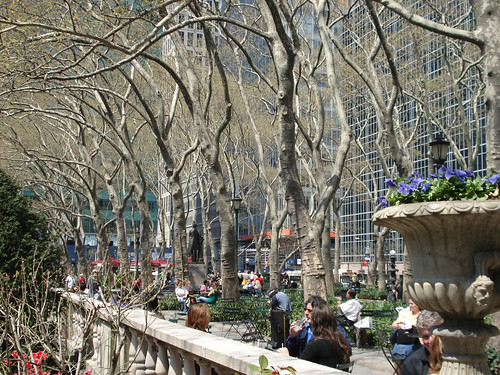 If left to our own travel plans, we probably would have blown off the touristy sites in favor of more food, but P's uncle Warren swept us out of the house and into the city for a walking tour of Midtown. In the span of two hours, Warren gave us an in-depth architectural history of more sites than we would see for the rest of the week. Empire State Building. Check. Chysler Building. Check. Central Library. Check. Grand Central Station and a nearby Earth Day festival. Double check.
If left to our own travel plans, we probably would have blown off the touristy sites in favor of more food, but P's uncle Warren swept us out of the house and into the city for a walking tour of Midtown. In the span of two hours, Warren gave us an in-depth architectural history of more sites than we would see for the rest of the week. Empire State Building. Check. Chysler Building. Check. Central Library. Check. Grand Central Station and a nearby Earth Day festival. Double check.
Not to worry - the rest of the day was spent tracking down food. After a pleasant outdoor lunch on Bryant Park, we rendezvoused with A's friend Hannah at her Brooklyn apartment. Still thinking of New York in terms of Portland-scale (a hang-up we'd have for most of the trip), we decided to take a "quick" jaunt down to Red Hook to find some key lime pies we'd heard about. Hannah, the most seasoned of the three of us, knew the trip would take over an hour, but she was easy-going and we were determined, so we ventured out undeterred. 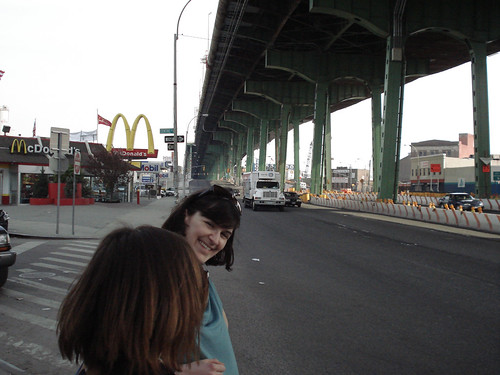 After a long subway ride, we were treated to an even longer walk across a warehouse-district of chop-shops and housing projects. Safe? Maybe not. Classic P & A trip? Most definitely. Still, Brooklyn is a funny place; where else would you emerge from a half-mile of identical project complexes to find a full organic farm and an IKEA?
After a long subway ride, we were treated to an even longer walk across a warehouse-district of chop-shops and housing projects. Safe? Maybe not. Classic P & A trip? Most definitely. Still, Brooklyn is a funny place; where else would you emerge from a half-mile of identical project complexes to find a full organic farm and an IKEA?
At long, sweaty last, we reached our destination - Steve's Authentic Key Lime Pies. This was a very good thing, because at this point Hannah was beginning to doubt not only our navigational skills, but the very existence of key lime pie in Red Hook. 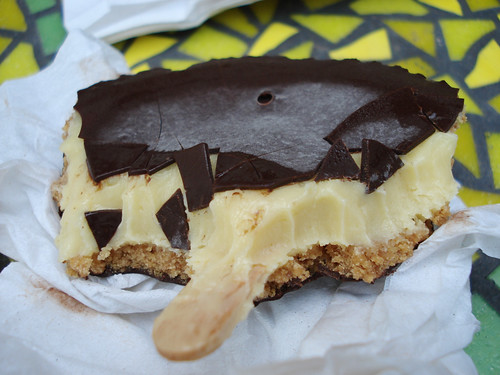 But there it was, hidden inside a tropical-oasis garden center on the end of a pier. The name of Steve's place is accurate because they serve nothing other than key lime pie, doing most of their business with grocers and special pie orders. So did we really venture to the furthest tip of Brooklyn to eat a whole pie? No - we came for the Swingle. This delicious confection consists of a miniature key lime pie, frozen, dipped in chocolate, and on a stick. It is cool, tart, creamy and refreshing. Simply put, it blows other stick-foods out of the water. The corn dog, the popsicle, the kebab - none of these delicacies compare to the glory of the Swingle. A is already planning home-spun Swingle tributes to enjoy over the Portland summer.
But there it was, hidden inside a tropical-oasis garden center on the end of a pier. The name of Steve's place is accurate because they serve nothing other than key lime pie, doing most of their business with grocers and special pie orders. So did we really venture to the furthest tip of Brooklyn to eat a whole pie? No - we came for the Swingle. This delicious confection consists of a miniature key lime pie, frozen, dipped in chocolate, and on a stick. It is cool, tart, creamy and refreshing. Simply put, it blows other stick-foods out of the water. The corn dog, the popsicle, the kebab - none of these delicacies compare to the glory of the Swingle. A is already planning home-spun Swingle tributes to enjoy over the Portland summer.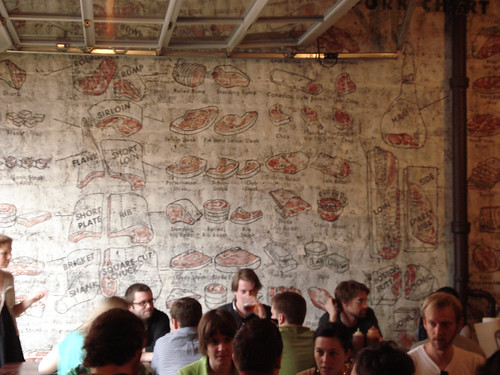 Thus revived, we decided to get dinner. Back up in Williamsburg, we headed to Fette Sau, a Brooklyn barbecue joint that is essentially a well-decorated alley. At the counter, we selected from assorted piles of meat and paid by the pound. At the bar, we ordered local microbrews by the half- or full gallon. This was bulk eating we could get behind. Our baking sheet full of food included pulled pork shoulder, spicy sausage, pork ribs, burnt-end beans, half-sour pickles, and yeasty rolls. The ribs were underwhelming, but everything else more than whelmed us. The pulled pork was sweet and tender and brightened by the vinegar sauce served on the side.
Thus revived, we decided to get dinner. Back up in Williamsburg, we headed to Fette Sau, a Brooklyn barbecue joint that is essentially a well-decorated alley. At the counter, we selected from assorted piles of meat and paid by the pound. At the bar, we ordered local microbrews by the half- or full gallon. This was bulk eating we could get behind. Our baking sheet full of food included pulled pork shoulder, spicy sausage, pork ribs, burnt-end beans, half-sour pickles, and yeasty rolls. The ribs were underwhelming, but everything else more than whelmed us. The pulled pork was sweet and tender and brightened by the vinegar sauce served on the side. 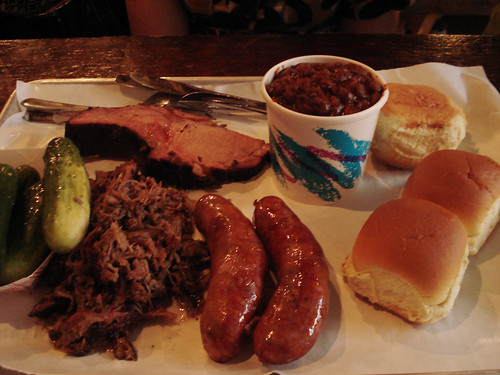 We devoured the smoky-sweet beans and loved the half-sours (see the parallels between deli pastrami and bbq?). Still, it was the spicy sausage that stood out above the rest, especially when accompanied by the sweet Georgia BBQ sauce and sopped up with a bit of fluffy roll. They tasted like spicy kielbasa and P swears they were braised in Coca-Cola. Despite being washed down with some Black Wheat beer from Sixpoint Brewery, all of that salty food put us in the mood for some dessert.
We devoured the smoky-sweet beans and loved the half-sours (see the parallels between deli pastrami and bbq?). Still, it was the spicy sausage that stood out above the rest, especially when accompanied by the sweet Georgia BBQ sauce and sopped up with a bit of fluffy roll. They tasted like spicy kielbasa and P swears they were braised in Coca-Cola. Despite being washed down with some Black Wheat beer from Sixpoint Brewery, all of that salty food put us in the mood for some dessert.
You all know that we have a special place in our hearts for carts, 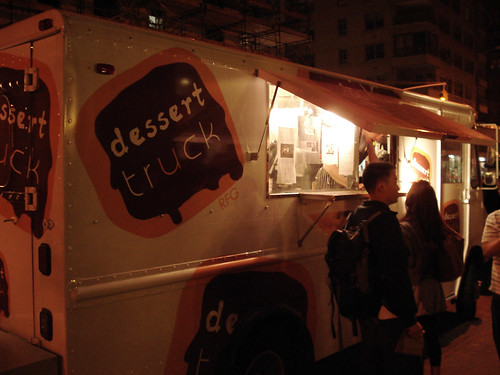 so it should come as no surprise that we got our dessert from a truck. Not just any truck, but a truck with fine dining credentials. Started by a former Le Cirque pastry chef and his friend, Dessert Truck has been serving $5 gourmet desserts for the last year from a corner near NYU. These are gourmet desserts for the people. A and Hannah both opted for the obligatory peanut butter and chocolate concoction: a chocolate mousse with a creamy peanut butter center and caramel popcorn on top.
so it should come as no surprise that we got our dessert from a truck. Not just any truck, but a truck with fine dining credentials. Started by a former Le Cirque pastry chef and his friend, Dessert Truck has been serving $5 gourmet desserts for the last year from a corner near NYU. These are gourmet desserts for the people. A and Hannah both opted for the obligatory peanut butter and chocolate concoction: a chocolate mousse with a creamy peanut butter center and caramel popcorn on top. 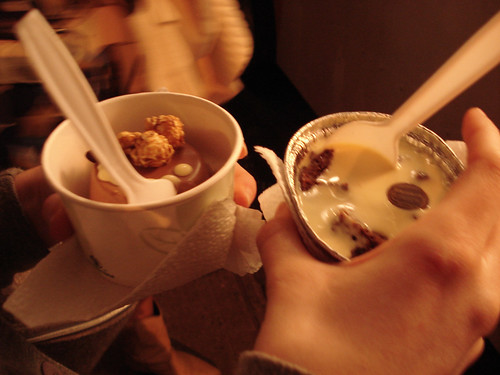 It was delicious, playful, and reminiscent of childhood treats - an upscale Reese's peanut butter cup, if you will. It must be said, however, that P's choice took the cake (or, rather, the bread pudding). The decadent chocolate bread pudding (almost like an ultra-rich mousse) was topped with a creme anglaise and, not having had enough pork for one evening, P opted for the special bacon infused cream. Oink, oink.
It was delicious, playful, and reminiscent of childhood treats - an upscale Reese's peanut butter cup, if you will. It must be said, however, that P's choice took the cake (or, rather, the bread pudding). The decadent chocolate bread pudding (almost like an ultra-rich mousse) was topped with a creme anglaise and, not having had enough pork for one evening, P opted for the special bacon infused cream. Oink, oink.
This may seem like a bout of frantic eating (all of the food above was consumed in the span of four hours), but in all fairness, we were on deadline. The next morning we would be leaving the city for two days to visit P's grandparents in Scranton, PA, a place not known for its rich culinary legacy...
or is it?
_________
Steve's Key Lime Pies - Pier 41, 204 Van Dyke St, Brooklyn; good luck figuring out a close subway
Fette Sau - 354 Metropolitan Ave, Brooklyn; L @ Bedford
Dessert Truck - University Pl. nr. 8th St.; 6 @ Astor Place; N, R, W @ NYU/8th
Wednesday, April 16, 2008
from the dept. of mobile dining
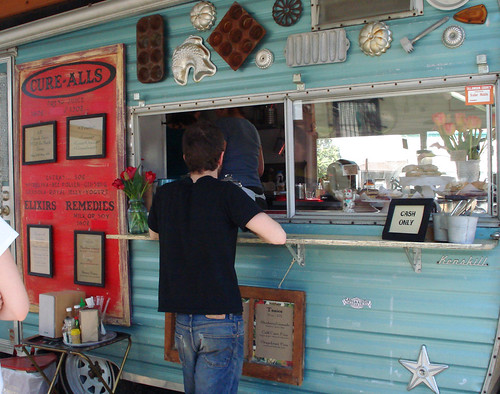 When the weather is as unseasonably beautiful as it was last week, what better to do than to bike out (mobile) and sample some N. Mississippi food carts (also mobile)? Of course you can't think of an answer to that question; that's what makes it rhetorical. And we couldn't think of a suitable response either (even though we had plenty of other errands to take care of), so off we went on our new bikes to seek out some early spring bites.
When the weather is as unseasonably beautiful as it was last week, what better to do than to bike out (mobile) and sample some N. Mississippi food carts (also mobile)? Of course you can't think of an answer to that question; that's what makes it rhetorical. And we couldn't think of a suitable response either (even though we had plenty of other errands to take care of), so off we went on our new bikes to seek out some early spring bites.
After huffing and puffing our way over to North Portland (hey, it's been a while since we've ridden across town - rainy-old-Portland's a tough place to bike half the year!), we pulled up to Moxie Rx. Take all of the Americana kitsch of a roadside dinner and cram it into a sunny little turquoise-and-red trailer and you've got a sense of what Moxie looks like. Sitting on their lot makes you feel like you're somewhere in the South, maybe Texas. The food, though, is 100% Portland, focusing on "elixirs" and "tonics" (juice blends) and comforting breakfast sandwiches and pastries that would probably fill the 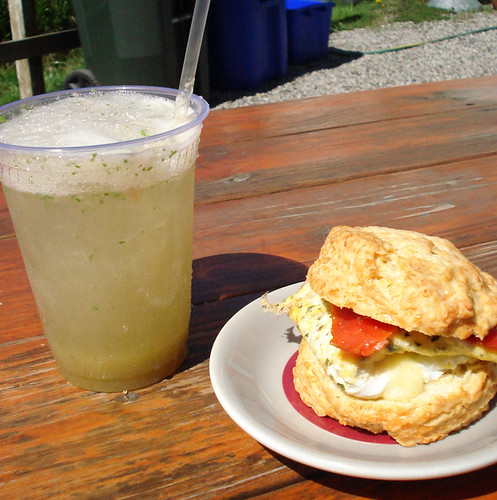 prescription just as well for a hangover cure as for a bright-eyed early riser. We'd gotten there around noon, so many of their breakfast options were sadly sold out. We decided to share a homemade cheddar biscuit with an herbed egg and smoked salmon, along with a grapefruit fizz (fresh-squeezed grapefruit juice, basil, soda water) to cool us off from the hot ride over. The biscuit was cute-as-a-button and very tasty; its cheese just beginning to melt from the heat of the egg. Our freshly-blended soda was just the refreshing sip that we needed and it made us anxious for summer weather. But we were still hungry (surprise!), so we climbed back on our bikes and pedaled a little ways up the street.
prescription just as well for a hangover cure as for a bright-eyed early riser. We'd gotten there around noon, so many of their breakfast options were sadly sold out. We decided to share a homemade cheddar biscuit with an herbed egg and smoked salmon, along with a grapefruit fizz (fresh-squeezed grapefruit juice, basil, soda water) to cool us off from the hot ride over. The biscuit was cute-as-a-button and very tasty; its cheese just beginning to melt from the heat of the egg. Our freshly-blended soda was just the refreshing sip that we needed and it made us anxious for summer weather. But we were still hungry (surprise!), so we climbed back on our bikes and pedaled a little ways up the street.
Junior Ambassador's looks more like a Home Depot storage shed than something on wheels, but that doesn't slow its emissary down from sharing his Mostlandian home cuisine with Portlanders. Springing out of the diplomatic successes of their early ice cream deliveries, Rudy (the T. in the M.O.S.T), started a food cart featuring panwiches (savory pancake-sandwiches) and fresh, unusual ice creams. We shared a Turkey Ruby panwich (turkey and red cabbage sauerkraut on rye pancake), which was toothsome and delicious. The pancake was much denser than a breakfast flapjake, probably yeasted, and more like a muffin or sponge-y blin. Before we'd even finished our panwich though, we already had our ice cream requests in: one strawberry chipotle and one maple "strip tease." The strawberry could have had more of the smokiness from the chipotle peppers, but it did have a nice, very subtle spiciness. The maple flavor, however, was a perfect 10 with just the right amount of sweetness. As for the "strip tease?" That would be a bacon strip, the crispy, salty bits of which perk up every single bite.
muffin or sponge-y blin. Before we'd even finished our panwich though, we already had our ice cream requests in: one strawberry chipotle and one maple "strip tease." The strawberry could have had more of the smokiness from the chipotle peppers, but it did have a nice, very subtle spiciness. The maple flavor, however, was a perfect 10 with just the right amount of sweetness. As for the "strip tease?" That would be a bacon strip, the crispy, salty bits of which perk up every single bite. Now, rather than only regaling you with tales of what we already ate, this post has a participation portion! This Saturday, if you are in Portland, Willamette Week and foodcartsportland.com are hosting a food cart confab called Eat Mobile, featuring Altengartz Bratwurst, Asian Station Cafe, Biggs Bros Wings, Micro-Mercantes (homemade Tamales), India Chaat House, Junior Ambassador, Julia’s Mobile Cafe (Russian Food), Moxie RX, NW Hotdogs (Mercy Corps vendor), Tabor (czech food), Tita’s Pista. We can't tell you about a lot of these places, but we can definitely speak to the awesomeness of Jr. A's, Moxie and Chaat House. Since we'll be out of town (eating from New York carts, no doubt), the duty falls upon you all to go as our representatives and eat like you imagine we would.
Now, rather than only regaling you with tales of what we already ate, this post has a participation portion! This Saturday, if you are in Portland, Willamette Week and foodcartsportland.com are hosting a food cart confab called Eat Mobile, featuring Altengartz Bratwurst, Asian Station Cafe, Biggs Bros Wings, Micro-Mercantes (homemade Tamales), India Chaat House, Junior Ambassador, Julia’s Mobile Cafe (Russian Food), Moxie RX, NW Hotdogs (Mercy Corps vendor), Tabor (czech food), Tita’s Pista. We can't tell you about a lot of these places, but we can definitely speak to the awesomeness of Jr. A's, Moxie and Chaat House. Since we'll be out of town (eating from New York carts, no doubt), the duty falls upon you all to go as our representatives and eat like you imagine we would.
It's only five dollars.
There will be one-dollar Bridgeport beers.
All of the money goes to help MercyCorps NW's awesome small-business programs (which help out a lot of local restaurants).
See the Willamette Week site for details/directions.
Posted by
p
at
10:35 PM
0
comments
![]()
Tuesday, April 15, 2008
things that make me feel smart, part 2
Psycho-geography.
Future ruins.
Experimental landscapes.
Urban spelunking.
Spatial theoretics.
Sonic architecture.
If UNIVERSE had enough indie cred to prevent me from seeming like a total geek, then this list of topics surely bursts that bubble. Well, I'm fine with that, because they're damn fascinating. So, while I know that we'll probably be seeing more food than architecture, it still seems appropriate that on the eve of our trip to New York I'd introduce you to one of my favorite urban spaces/architecture sites, BLDGBLOG. Written by Geoff Manaugh, a Senior Editor at Dwell magazine (hey, that makes this sort of hip, right?), BLDGBLOG presents consistently thought-provoking ideas about the built environment and what if... scenarios for the future.
Written by Geoff Manaugh, a Senior Editor at Dwell magazine (hey, that makes this sort of hip, right?), BLDGBLOG presents consistently thought-provoking ideas about the built environment and what if... scenarios for the future.  When you start following the items and jaw-dropping photography (like this image of drainage spelunking in Canada) that Manaugh covers, you begin to realize that architecture is a lot weirder than you ever imagined.
When you start following the items and jaw-dropping photography (like this image of drainage spelunking in Canada) that Manaugh covers, you begin to realize that architecture is a lot weirder than you ever imagined.
Take for instance this story from the Guardian about a plan to construct a warehouse for unwanted books. To continue preserving books that no one is using, British libraries are constructing vast, windowless buildings in the industrial outskirts of London. Not for access, mind you, just for archival.
Or how about this urban design proposal that has been circulating for a few years now: What should Philadelphia do with it's overgrown, abandoned urban lots? Put them into production growing the city's food, of course. Enter Farmadelphia, a plan to revisit the agrarian past of Philly. But this project didn't just imagine a network of run-of-the-mill community garden plots; the designer's renderings proposed a full-scale agriculture of grazing livestock, rotational crops and wheat fields! So, for a good sense of just how weird our constructed landscape is, take a look at:
So, for a good sense of just how weird our constructed landscape is, take a look at:
- One of the posts that got me hooked on this site: San Francisco's foundations are built on abandoned, scuttled ships
- The construction of ultra-luxe zoos and their promises for future suburban development
- The role of environmental toxins in aging
- Olympic security in Beijing, CCTV, and the future of reality film-making
- The calls of city songbirds are actually changing their cadence and pitch
- First the Louvre in Abu Dhabi, and now Dubai has purchased the rights to recreate and the city of Lyons
You might be able to speculate on it, but you just can't make this stuff up.
Posted by
p
at
8:35 PM
0
comments
![]()
Labels: architecture
Friday, April 4, 2008
the godfather
We all have certain books sitting on our shelves that we know we ought to read, but always postpone. They frequently are books lent by friends or classics that we've been shamed into adding to our list. My own guilty example is Swann's Way by Proust. It is not something of which I'm proud - I picked it up when I was still taking French and because it struck teenage-me as a book that broadcasts intelligence - but when I notice it on our bookcase, it weighs on me with a heavy feeling of obligation. I've tried to read that book so many damn times and I just have to say: when a book begins with a discussion of sleeping habits, I'm probably not going to last. That said, I came across the most wonderful surprise of a book this last weekend when I resigned myself to picking up one of these abandoned books and slogging through it. Happily though, it only took a few words of Angelo Pellegrini's introduction before I was wholly hooked and readily devouring his story. I can best describe The Unprejudiced Palate as the soapbox of a charming, practically-minded, opinionated (as when he entirely dismisses saffron) and very progressive bon vivant. Full of grand, declarative pronouncements on how to eat (which, as the New York Time recently pointed out, the Italians do with such aplomb), Pellegrini's writing offers one of the most coherent arguments for the good life that I have ever read. Even throughout the last third of the book - which he devotes entirely to recipes - Pellegrini remains thoroughly readable, precisely because all of his recipes are penned in such a clear and persuasive voice.
That said, I came across the most wonderful surprise of a book this last weekend when I resigned myself to picking up one of these abandoned books and slogging through it. Happily though, it only took a few words of Angelo Pellegrini's introduction before I was wholly hooked and readily devouring his story. I can best describe The Unprejudiced Palate as the soapbox of a charming, practically-minded, opinionated (as when he entirely dismisses saffron) and very progressive bon vivant. Full of grand, declarative pronouncements on how to eat (which, as the New York Time recently pointed out, the Italians do with such aplomb), Pellegrini's writing offers one of the most coherent arguments for the good life that I have ever read. Even throughout the last third of the book - which he devotes entirely to recipes - Pellegrini remains thoroughly readable, precisely because all of his recipes are penned in such a clear and persuasive voice.
Do not mistake Pellegrini for some over-privileged epicure - all of his statements are firmly rooted in the value he places in honest labor and cultural knowledge. He advocates humility and tradition over decadence and indulgence and, because of this, sounds as though he is writing from the middle of the current dialogue over the politics of sustainable food. Over the last week since I read his book, I have come across numerous articles that show just how contemporary The Unprejudiced Palate is for having been written in 1948.
Last week in the New York Times, Eric Asimov offered his opinion on how parents should introduce their kids to alcohol, which brought to mind one of my favorite passages from the book:
"One summer morning several years ago, I was having an early breakfast with my three-year-old daughter in a small hotel in Utah. When the waitress asked what I wished to drink, the little girl announced to the bleary-eyed salesmen and the shocked grandmothers in the dining room that she would take coffee if they put a little rum in it. Since I had anticipated the possibility of frustration en route, I drew a little flask from my brief case and obliged the infant toper with a spoonful of rum in her coffee and milk. When we left the dining room, I felt certain that in the opinion of my fellow guests I hadn't scored much higher than an old soak and a corrupter of youth.
If, however, there was any wise among them, they must have seen in the incident a practical lesson in temperance. My daughter is now twelve. She still takes a teaspoonful of rum in her coffee and milk every morning. To date she has consumed approximately four thousand teaspoonfuls, or enough, say, to kill a whole circus of elephants."
This glib tone paired with common sense is absolutely classic Pellegrini. From the immigrant's point of view (Pellegrini came to the States shortly before the Depression), all of the brouhaha surrounding booze in the US is patently absurd and fully the result of a skewed relationship with food. "The self-appointed arbiters of the American's liquid diet," he writes, "have perverted that Hellenic virtue into a Puritan vice." Precisely by removing wine and drink from everyday conviviality and relegating it to bars, Pellegrini believes that Americans created their own drinking problem. Simply put: if you raise someone to appreciate the craft involved in alcohol and its place in a culture, they'll grow up to respect it.
Pellegrini argues that this embrace of excess in things that should be appreciated in their rarity is at the heart of America's distorted notions about food and health. One of the most interesting aspects of The Unprejudiced Palate is the abundance that Pellegrini finds in even the leanest of times and with the humblest of ingredients.
"A bunch of green onions, a few herbs, a handful of spinach, a little grated cheese and six eggs, can be fused into a delicious main course for the average family. The possibilities for going somewhere from nowhere are literally unlimited. They cannot be learned, of course, by those who persist in going to the grave on meat, potatoes, and gravy."
Because Americans have latched onto a handful of foods and consumed them in epic proportions, they have not only sacrificed their health, but also a lot of their ability to cook and even appreciate the value in alternatives to their current ways. By letting go of the myriad edible joys in the world and forgetting what they tasted like, it was a short step before stores were filled with imitation foods - the block cheddar "cheese" and bologna "salamis" that so perplexed the young, newly arrived Pellegrini. To me, this sounds a lot like Michael Pollan's recent talk in Portland in which he discussed the inviolable position of meat in the American diet:
But truly, the greatest argument Pellegrini makes for switching your diet towards more whole foods and vegetables is that, when freshly picked, there is simply nothing better:
"But above all else, they [two sewer-worker (and Italian) friends of Pellegrini] take great delight in eating what they produce in their gardens. While they argue about anything under the sun, and even about some things above the sun, they can never find reason to quarrel about this: that you can't beat what you grow in your own garden."
Across the country, growing numbers of people are currently seeing the value in replanting portions of their lawns or ornamental gardens with edible crops. In a sense, it is a return to the victory gardens that were so successful when Pellegrini was writing. Between a recent CHOW article on urban vegetable gardening, Fritz Haeg's Edible Estates, businesses like Your Backyard Farmer, and the "Food Not Lawns" movement, it is clear that people agree with Pellegrini on the importance of connecting with your food from soil to table.
"If you like your fruit ripened on the tree, bathed with the early morning dew or warmed to it very core by the midday sun, you must grow it on your little plot of earth. If you live in a climate where that is not possible, or if you are among the unfortunate millions caged in dainty little flats, I weep for you a brother's tears of compassion while I pray for your early release from bondage. But if you have the necessary facilities and still prefer the shade of the willow to the taste of a ripe peach, well, who am I that I should intrude upon your eccentricities?"
What struck me about the people's stories in the CHOW article were the vehemently negative reactions some of these gardeners received. It never ceases to amaze me how angry people can get when others strive to do better (or even just do "different"). Take for example this recent lambasting of Slow Food from Metropolis. I fail to understand where the author's apparent anger comes from - is he honestly defending McDonald's? Even if he is, how is it a problem for him that Slow Food hopes to preserve food traditions from being lost to the advance of narrowing, standardized food choices? And you don't have to read the well-written rebuttal (but you still should) to understand just how poorly Sterling understands what Slow Food does. All of his loaded language (ignore all of the word choices like "infiltrate" and just try looking up "myrmidon" in a dictionary) makes it seem as though Slow Food is a conspiracy to secure luxury comestibles for the super-wealthy. In fact, what Slow Food does is work to increase access for everyone to a diversity of foods - the very foods that used to (and, in many parts of the world, still do) sustain cultures that are the very opposite of privileged. And, I hate to have to explain it this simply, but food cannot exist in a vacuum - there need to be consumers in order for producers to have an outlet for their work.
So what really irritates me (& I believe would vex Pellegrini as well) is this tired and unfounded critique of enjoying good food as being elitist. As Pellegrini wrote (and he heaps just as much blame on chefs as on "gourmets"):
"They have broadcast a dastardly falsehood, perhaps to give a certain status to their labor of love - that cooking is an art. The implication of all their dithyrambic spewings on culinary matters, despite their protestations to the contrary, is that excellent food and drink are achievements in refinement beyond the attainment of ordinary mortals. [...]
The prevailing view seems to be that the preparation of a dinner in any way out of the ordinary means hours and hours in the kitchen and "an artist's touch" in the transmutation of ingredients. This notion, for which the precious cookery books are responsible, is as erroneous as it is widespread." Essentially, as Pellegrini argues, enjoying and creating wholesome, delicious food has been distorted into snobbery; as cooking became equated with art, eating changed into an act of purely aesthetic connoisseurship. (While we are on the subject, can we agree to stop using the term "snob" as though it is a good thing? I understand the concept behind embracing a maligned term for something you love, but does "wine snob" or "music snob" or any such snobbery really do your passion justice?) What is required to rescue food from its removed, rarefied pedestal is exactly what Slow Food does - getting eaters to directly engage with it. Too many people, Pellegrini scolds,
Essentially, as Pellegrini argues, enjoying and creating wholesome, delicious food has been distorted into snobbery; as cooking became equated with art, eating changed into an act of purely aesthetic connoisseurship. (While we are on the subject, can we agree to stop using the term "snob" as though it is a good thing? I understand the concept behind embracing a maligned term for something you love, but does "wine snob" or "music snob" or any such snobbery really do your passion justice?) What is required to rescue food from its removed, rarefied pedestal is exactly what Slow Food does - getting eaters to directly engage with it. Too many people, Pellegrini scolds,
"...are sufficiently urbane and metropolitan to enjoy heartily a good dinner when it is served to them, but their gastronomic self has remained immature out of sheer neglect. [...] The difference between a gourmet and one who eats macaroni salad is precisely the difference between one who enjoys turnip greens and will bestir himself to satisfy a desire, and one who enjoys them but will do nothing about it."
To help restore the lost dignity of simple foods and cultural traditions, Pellegrini argues, we need to be willing to try our hand at tending our own gardens, stirring pots, and crushing grapes. We simply must reconnect with the labor and craft of eating. I can not imagine a better duty.
Posted by
p
at
6:35 PM
0
comments
![]()



